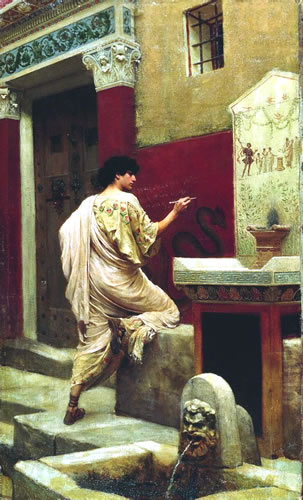Ancient graffiti. Scripta currente et verba vulgata

Next to the Latin scholar and "monumental" there existed not only the Latin spoken in the streets but also the one written on the walls, and it may happen that visiting precisely the Roman Forum and the Palatine you can find these ancient graffiti.
Scholars call this type of writing cursive capital because it is denoted by the uppercase character of the letters and the ductus (trend) of the writing where the letters are unrelated to each other and disjointed mainly due to the support, the wall or the tablet, which involves the use of the scratch technique, the result of which is what we now call graffiti.
To obtain this type of writing it was used the graphium, a kind of burin in various materials sufficiently hard to be able to trace marks on the waxed wooden tablets; it could be about 20-25 cm long and on one side it ended pointy for writing and on the other it was wide and flat to be able to erase.
Many Romans used to bring with them the graphium closed in a case and it could be of various materials: iron, bronze but also of gold, silver, copper and bone. Graphiums were also used as real weapons; Suetonius tells that Julius Caesar attempted to defend himself by striking Cassius on the arm with his iron graphium and, again Suetonius, that Caligula had the hostile senators killed with graphiis when they were in the Senate. Another anecdote about the improper use of the instrument is told by Prudentianus for the martyrdom of Saint Cassian (3rd century) killed by his disciples who hit him with their own graphia of bone.
As graphium you could use any rough metal tool that could leave marks on a support that could be random like a wooden board or the plaster of a wall.
In this type of writing, just because of the difficulty of drawing the sign, it happens that the letters are represented with parallel lines resulting strongly stylized; to give examples:
It may seem impossible but graffiti has also been found in the House of Augustus where many are visible in the room of the Masks especially. This room was built around 30 BC and however incredible the graffiti also dates back to the Augustan age: they were the slaves who worked in the imperial domus to write their thoughts on the walls.
In the Domus Augusti the Room of the Masks was a service room and for this reason slaves often stopped there; in this room on the wall in which a sanctuary is depicted, next to the column on the left between the red band and partly the pink one, at 125 cm in height there is the inscription "Quinto".
And further down on the left
This graffiti shows how often ancient graffiti are not easy to interpret precisely because, like epigraphs, there were many contractions and elisions; in this graffiti according to the interpretation found in CIL IV 2146 the complete sentence would be:
Vibius Restitutus has slept here alone and wanted his Urbana.
Beyond the Palatine Hill, there are other places where they can be seen graffiti dating from different periods, such as the Arch of Janus Quadrifrons, on side facing the Palatine Hill, where the name of Constant II is engraved, probably during the visit of the emperor in Rome where he arrived on 5 July 663 and was also the last visit of an emperor in Rome.
A particular graffiti was found in the underground of Santa Maria Maggiore, which are in fact relevant to a Roman villa of the second century BC and of which some rooms can be visited that probably correspond to the service rooms that were frequented above all by slaves. Among the signs left by the slaves one can see the Sator or "magic square" - also found in other places of the Empire like Pompeii and Lugdunum - considered one of the oldest cryptograms to which, according to some historians, the founding message of the Christian religion would be entrusted .
But there are also graffiti in classical Latin language, are those that can be seen engraved in the plaster in the arcades of the Basilica Argentaria. They are verses of Aeneid of Virgil that scholars hypothesize to have been engraved by pupils of one of the scholae who had their seat here at the time of the late empire. The disciples on the walls had also designed some stylized figures and jeered their master Caecilius Eros.
A very famous "scholastic" graffiti is the one found engraved on the pedagogium plaster attached to the imperial domus on the Palatine Hill. The pedagogium was the place where the young slaves assigned to the residence of the princeps were instructed. The graffiti, of Severan era, is a mockery of a certain Alexamenos and the Greek text says "Alexamenos Sebete theon" or "Alexamenos worships God"; the graffiti was probably the work of a slave who joked about the Christian faith of Alexamenos that is represented while worshiping a donkey on the cross. The explanation of the god with an ass's head is in the confusion between the Christian religion and the Jewish religion as the pagan Romans did not understand the difference and at the depiction of the god with donkey attributes was an expression of irreverence towards the monotheistic religions ...
Sign up and read the rest of the article!
by M.L. ©ALL RIGHTS RESERVED (Ed 1.0 - 03/12/2019)






